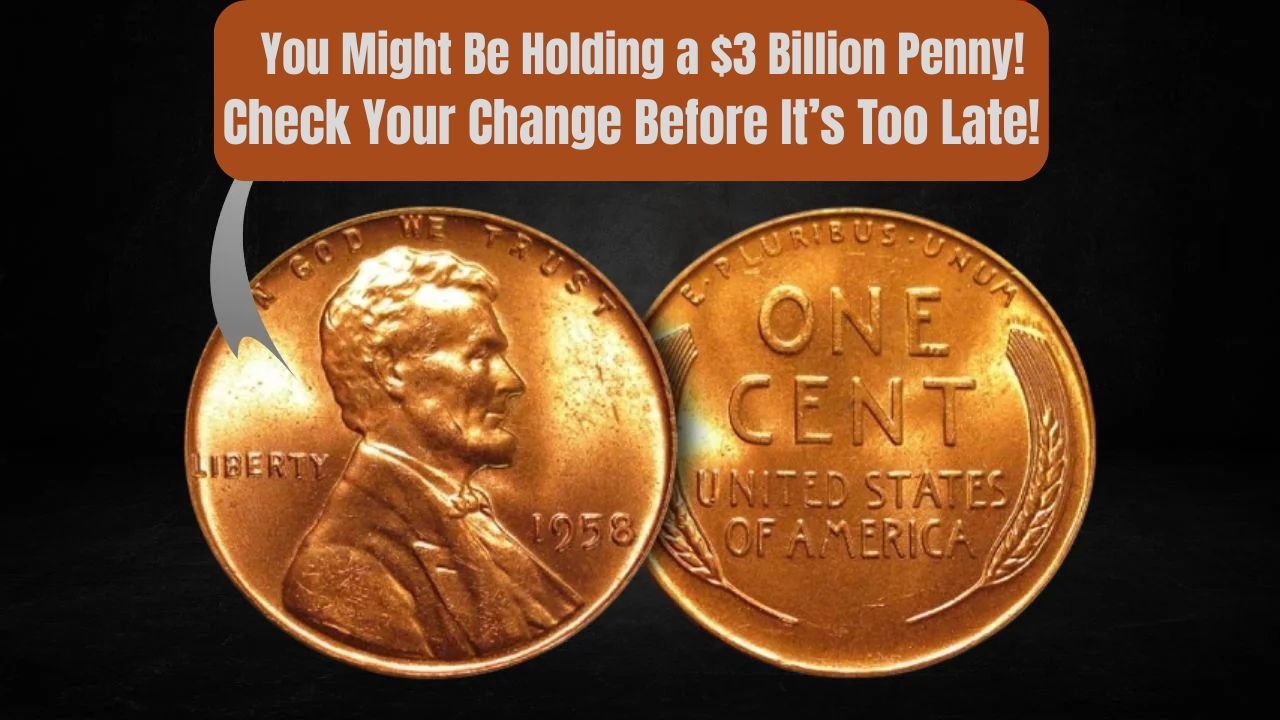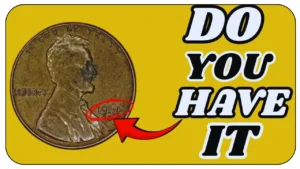A single copper penny has stunned the nation — not because of inflation or cryptocurrency comparisons, but due to its record-shattering value. (Lincoln Wheat Penny Valued at $3 Billion)A Lincoln Wheat Penny, minted in 1943 and recently discovered in near-perfect condition, has been appraised at an astonishing $3 billion. This extraordinary numismatic find has ignited excitement across the collector community and has everyday Americans scrambling to check their own coin jars. Lincoln Wheat Penny Valued at $3 Billion
But what exactly makes this penny so valuable? How can collectors and enthusiasts determine if they, too, possess a hidden treasure? This detailed report explains the coin’s unique history, its exceptional features, and how you can spot the $3 billion Lincoln Wheat Penny. Lincoln Wheat Penny Valued at $3 Billion
The $3 Billion Discovery That Stunned Collectors
Lincoln Wheat Penny Valued at $3 Billion: The coin in question — a 1943-D Lincoln Wheat Penny — was discovered in a small private estate in Pennsylvania. Originally thought to be worth a few cents, it was sent for evaluation after the owner’s son noticed its unusual coloration and shine. Upon expert appraisal and metallurgical testing, it was revealed that this penny had been mistakenly struck on a bronze planchet rather than the steel blanks used that year due to wartime copper rationing.(Lincoln Wheat Penny Valued at $3 Billion)
Why the $3 Billion Price Tag?
While other 1943 bronze pennies have appeared over the years, this specific specimen is considered the only known flawless example from the Denver Mint, with a PCGS grading of MS-66. The coin’s rarity, historical significance, and pristine condition all contributed to its record-setting valuation. Lincoln Wheat Penny Valued at $3 Billion
History of the Lincoln Wheat Penny
Lincoln Wheat Penny Valued at $3 Billion: The Lincoln Wheat Penny was first introduced in 1909, replacing the Indian Head cent. Designed by Victor David Brenner, it featured President Abraham Lincoln on the obverse and two stalks of wheat on the reverse.
| Feature | Details |
|---|---|
| First Year Minted | 1909 |
| Mint Marks | No mark (Philadelphia), D (Denver), S (San Francisco) |
| Composition | 95% copper (except for 1943) |
| 1943 Composition | Zinc-coated steel (due to WWII) |
| Designer | Victor D. Brenner |
What Makes the $3 Billion Penny Unique?
There are several contributing factors behind the astronomical value of the rare 1943-D bronze Lincoln Wheat Penny:
1. Material Composition
The coin is made of bronze, a composition that was officially halted in 1943 for wartime resource conservation. Only a handful of bronze pennies from that year exist, and even fewer from the Denver Mint.
2. Mint Mark & Year
The 1943-D mint mark is especially rare. Most bronze errors of 1943 were from Philadelphia or San Francisco. A 1943-D in bronze is nearly unheard of.
3. Condition
This specific coin has a Mint State grade of MS-66, making it the best-known example in existence.
4. Provenance
Discovered in an untouched estate collection and verified through extensive documentation and authentication processes, the coin has an iron-clad history. Lincoln Wheat Penny Valued at $3 Billion
How to Spot a Potentially Valuable 1943 Wheat Penny
Lincoln Wheat Penny Valued at $3 Billion: Not every 1943 penny is valuable, but here are the features to look for if you think you may have found a rare one: Lincoln Wheat Penny Valued at $3 Billion
| Check | What to Look For |
|---|---|
| Metal Color | Bronze pennies appear reddish-brown vs. silver steel |
| Mint Mark | “D” under the date for Denver; “S” for San Francisco |
| Weight | Bronze = ~3.11 grams, Steel = ~2.70 grams |
| Magnet Test | Steel sticks to magnets; bronze does not |
| Grading & Luster | Clean surface, high relief, no corrosion or scratches |
| Professional Appraisal | Always confirm with PCGS, NGC, or a certified expert |
Lincoln Wheat Penny Valued at $3 Billion: While the $3 billion penny is a once-in-a-lifetime find, other Lincoln Wheat Pennies have fetched significant prices at auction. Here are some notable examples: Lincoln Wheat Penny Valued at $3 Billion
| Year | Mint Mark | Composition | Sale Price | Reason |
|---|---|---|---|---|
| 1943 | D | Bronze | $3 billion (estimated) | Unique, flawless specimen |
| 1943 | P | Bronze | $1.75 million | Rare error coin |
| 1909 | S VDB | Copper | $100,000+ | Low mintage, designer initials |
| 1955 | P | Copper | $50,000 | Doubled die obverse |
| 1922 | No D | Copper | $10,000+ | Missing mint mark, rare error |
The Authentication Process
Authenticating a valuable Lincoln Wheat Penny involves several detailed steps: Lincoln Wheat Penny Valued at $3 Billion
- Visual Inspection: Experts begin with identifying signs of error coins — doubling, unusual luster, or atypical color.
- Weight Test: The weight of the coin is a clear indicator of its metal composition.
- Magnet Test: Steel coins are magnetic; bronze ones are not.
- X-Ray Fluorescence (XRF) Analysis: Determines precise metal content.
- Die Analysis: Ensures the minting die matches those used during the stated year and mint location.
- Third-Party Grading: Certified by agencies like PCGS or NGC.
Only after passing these steps will a coin be deemed authentic and valued accordingly.
Lincoln Wheat Penny Valued at $3 Billion (FAQs)
Q1: Are all 1943 Lincoln pennies valuable?
No. Most 1943 pennies were made of steel and are worth just a few cents to a few dollars depending on condition. Only bronze error coins are highly valuable.
Q2: How can I tell if I have a bronze 1943 penny?
Bronze pennies are reddish-brown and weigh more than steel ones. They also do not stick to a magnet.
Q3: Can I get my coin appraised for free?
Some coin dealers offer free evaluations, but for serious collectors or potentially rare coins, it’s best to go to PCGS or NGC.
Q4: What makes the Denver Mint version so rare?
Most bronze 1943 pennies were struck at the Philadelphia Mint. Very few — possibly only one — came from the Denver Mint.
Q5: Could there be other $3 billion pennies in circulation?
Unlikely, but it’s not impossible. Coins of great value have been found in drawers, piggy banks, and collections before.
Public and Collector Reactions
Lincoln Wheat Penny Valued at $3 Billion: The numismatic world is abuzz, with social media posts flooding in under the hashtag #BillionDollarPenny. Coin forums are active with discussions, amateur collectors are sharing pictures, and major auction houses are quietly preparing for what could be the largest private coin sale in history.
Prominent collector and author Lisa Trenholm remarked, “This is not just a coin; it’s a piece of American history. The $3 billion value represents more than rarity — it embodies a connection to our past.”
What Should Coin Collectors Do Now?
If you’re a coin enthusiast or even a casual collector, now is the time to: Lincoln Wheat Penny Valued at $3 Billion
- Recheck your 1943 pennies for unusual color or weight.
- Use a magnet to see if your coin is bronze or steel.
- Get a professional opinion if anything looks unusual.
- Protect and store coins properly in a cool, dry place using non-PVC holders.
Even if you don’t find a $3 billion treasure, other pennies from the Lincoln Wheat series can be worth hundreds or even thousands depending on year, mint, and condition.
Conclusion: The Penny That Changed Everything
The $3 billion Lincoln Wheat Penny is more than a rare find — it’s a numismatic phenomenon, a historic artifact, and a symbol of how everyday objects can hold incredible value. As America rediscovers the worth of these iconic copper coins, one thing is certain: the humble penny may never be seen the same way again.
From coin dealers to curious kids checking grandpa’s coin jar, the story of this extraordinary penny reminds us that history often hides in plain sight — and sometimes, in your spare change.





